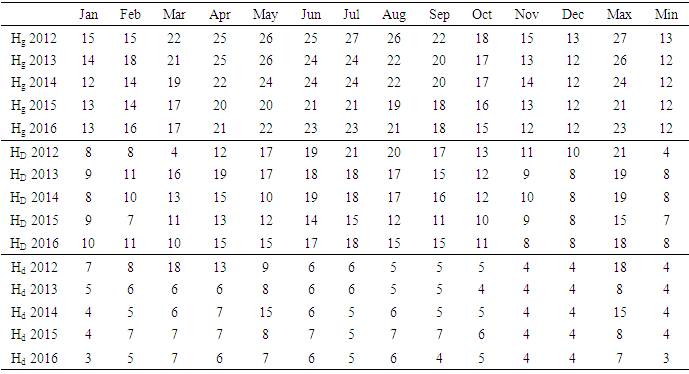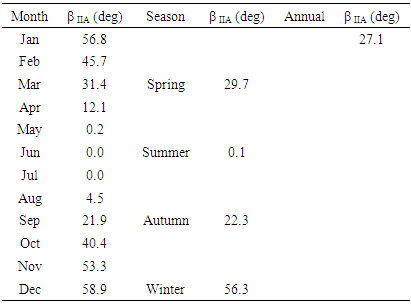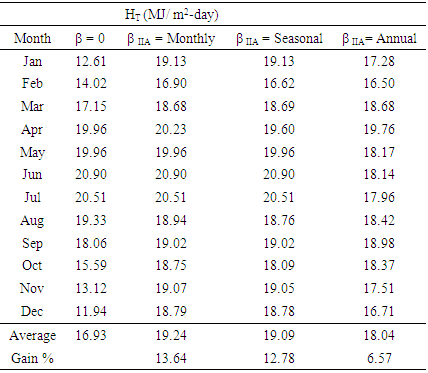| [1] | Genwa, K.; C. and Sagar, 2013. Energy efficiency, solar energy conversion and storage inphotogalvanic cell. Energy Convers. Manag.66, 121–126. |
| [2] | Demirhan, H.; T. Mentes and M. Atilla, 2013. Statistical comparison of global solar radiation, estimation models over Turkey. Energy Convers. Manag.68, 141–148. |
| [3] | Mohammadi, K. and H. Khorasanizadeh, 2015. A review of solar radiation on vertically mounted solar surfaces and proper azimuth angles in six Iranian major cities. Renewable and Sustainable Energy Reviews, Volume 47, July 2015, pp 504-518. [Crossref] |
| [4] | Khahro, S.F.; K. Tabbassum; S. Talpur; M.B. Alvi; X. Liao and L. Dong, 2015. Evaluation of solar energy resources by establishing empirical models for diffuse solar radiation on tilted surface and analysis for optimum tilt angle for a prospective location in southern region of Sindh, Pakistan. Electr. Power Energy Syst.64, 1073–1080. |
| [5] | Mojtaba S. and E.J. Javaran, 2017. "Optimising the tilt angle for solar surfaces using different solar irradiation models in Yazd, Iran", International Journal of Ambient Energy, 2017 39(4):1-32 • [Crossref] |
| [6] | Benghanem, M., 2011. Optimization of tilt angle for solar panel: Case study for Madinah, Saudi Arabia. Appl. Energy, 88, 1427–1433. |
| [7] | Soulayman, S.; A. Mohammad and N. Salah, 2016. Solar Receivers Optimum Tilt Angle at Southern Hemisphere. Open Access Library Journal. https://www.scirp.org/pdf/OALibJ_2016071311424605.pdf. |
| [8] | Skeiker, K., 2009. Optimum tilt angle and orientation for solar collectors in Syria. Energy Convers. Manag. 50, 2439–2448. |
| [9] | Lave, M. and J. Kleissl, 2011. Optimum fixed orientations and benefits of tracking for capturing solar radiation in the continental United States. Renew. Energy36, 1145–1152. |
| [10] | Bakirci, K., 2012. General models for optimum tilt angles of solar panels: Turkey case study. Renew. Sustain. Energy Rev., 16, 6149–59. |
| [11] | Jafarkazemi, F. and S.A. Saadabadi, 2013. Optimum tilt angle and orientation of solar surfaces in Abu Dhabi, UAE. Renew. Energy, 56, 44–49. |
| [12] | Khorasanizadeh, H.; K. Mohammadi and A. Mostafaeipour, 2014. Establishing a diffuse solar radiation model for determining the optimum tilt angle of solar surfaces in Tabass, Iran. Energy Convers. Manag.78, 805–814. |
| [13] | Yan, R.; T.K. Saha,; P. Meredith and S. Goodwin, 2013. Analysis of yearlong performance ofdifferently tilted photovoltaic systems in Brisbane, Australia. Energy Convers. Manag. 74, 102–108. |
| [14] | Hiraoka, S.; T. Fujii; H. Takakura and Y. Hamakawa, 2003. Tilt angle dependence of output, power in an 80kWp hybrid PV system installed at Shiga in Japan. Sol. Energy Mater. Sol. Cells, 75, 781–786. |
| [15] | Ibrahim, D., 1995. Optimum tilt angle for solar collectors used in Cyprus. Renew. Energy. 6, 813–819. |
| [16] | De Miguel, A.; J. Bilbao and M. Diez, 1995. Solar radiation incident on tilted surfaces in Burgos, Spain: Isotropic models. Energy Convers. Manag.36, 945–951. |
| [17] | Getu Hailu, and Alan S. Fung, 2019. Optimum Tilt Angle and Orientation of Photovoltaic Thermal System for Application in Greater Toronto Area, Canada. Sustainability 2019, 11, 6443. |
| [18] | Yunus Khan, T.M., Soudagar, M.E.M., Kanchan, M. et al. Optimum location and influence of tilt angle on performance of solar PV panels. J Therm Anal Calorim (2019). https://doi.org/10.1007/s10973-019-09089-5. |
| [19] | Morcos, V.H., 1994. Optimum tilt angle and orientation for solar collectors in Assiut, Egypt. Renew. Energy4, 291–298, doi:10.1016/0960-1481(94)90032-9. |
| [20] | Soulayman, S. 2018. "chapter 5 Optimum Tilt Angle Determine", IGI Global, [Crossref] |
| [21] | Asad Ullah; H. Imran; Z. Maqsood; and N. Z. But, 2019. Investigation of optimal tilt angles and effects of soiling on PV energy production in Pakistan. Renewable Energy, Elsevier, vol. 139(C), pages 830-843., [Crossref] |
| [22] | Salah, M.; A.K. Abdellatief and E. Nasser, 2008. Optimum tilt angle and orientation for a flat plate solar water heater under Egyptian conditions. J. Agric. Mach. Sci.4, 253–258. |
| [23] | Hussein, H.; G. Ahmad and H. El-Ghetany, 2004. Performance evaluation of photovoltaic modules at different tilt angles and orientations. Energy Convers.Manag.45, 2441–2452. |
| [24] | Elminir, H.K.; A.E Ghitas; F. El-Hussainy; R. Hamid; M. Beheary and K.M. Abdel-Moneim, 2006. Optimum solar flat-plate collector slope: Case study for Helwan, Egypt. Energy Convers. Manag. 47, 624–637. |
| [25] | Mahmoud El-Nouby Adam, Khalafallah Omar Kassem, Emad Ali Ahmed, 2013. Statistical relationship between UVB (280-320 nm) and broadband solar radiation (295-2800 nm) at a subtropical location (Qena, Egypt), Atmospheric and Oceanic Science Letters, 2013, Vol 6, No. 4, 173 – 178. |
| [26] | S. M. El Shazly, Kh. O. Kassem, A.A. Hassan, Eman F. EL-Nobi, 2012. An Empirical Model to Estimate UV index in Some Upper Egypt Regions, Resources and Environment 2012, 2(5): 216-227, DOI: 10.5923/j.re.20120205.05. |
| [27] | A.A Hassan, S.M Elshazly, Kh O Kassem, and E. El-Nobi, 2011. A Study of Uultraviolet Irradiation at Qena, Upper Egypt. Al-Azhar Bull. Sci. Vol. 22, No. 1(June): pp. 91-113. |
| [28] | S.M. El Shazly, A. A. Hassan, Kh. O. Kassem, M. E. Adam and Z.M. Ahmed. Estimating global and diffuse solar radiation from sunshine duration at Qena/ Egypt. Canadian Journal on Computing in Mathematics, Natural Sciences, Engineering and Medicine Vol. 2 No. 9, December 2011. |
| [29] | Martyn, D., 1992. Climates of the World; Elsevier: Amsterdam, The Netherland; London, UK; New York, NY, USA; Tokyo, Jinan; Pwn-Polish Scientific Publishers: Warszawa, Polandpp 199–225. |
| [30] | Kassem, Kh.O., 2014. Long Range Transport Contribution to PM10 Concentrations in a Subtropical City (Qena/Egypt). World Environ.4, 1–13,doi:10.5923/j.env.20140401.01. |
| [31] | Kassem, Kh.O., S.M. El-Shazzly, M. Takahashi and M.E.-N, Adam, 2009. Variability of surface ozone in some regions in Egypt. Ph. D. Thesis, pp 113-114. |
| [32] | El-Shazly, S.M.; Kh.O.Kassem; A.A. Hassan and E.A. Hala, 2012. Assessment of mixing height at Qena/Upper Egypt based on radiosonde data. Resour. Environ.2, 275–280. |
| [33] | Liu, B. and R. Jordan, 1961. Daily insulation on surfaces tilted towards equator. ASHRAE10, 53–59. |
| [34] | Amit K. Y. and S.S. Chandel, 2013. Tilt angle optimization to maximize incident solar radiation: A review. Renewable and Sustainable Energy Reviews, 23:503–513 [Crossref] |
| [35] | Duffie, J. and W. Beckman, 1991. Solar Engineering of Thermal Process; JohnWiley & Sons: New York, NY, USA. |
| [36] | Cooper, P.I., 1969. The absorption of radiation in solar stills. Sol. Energy, 12, 33–346,doi:10.1016/0038-092X(69)90047-4. |
| [37] | Badescu, V., 2002. 3D isotropic approximation for solar diffuse irradiance on tilted surfaces. Renew. Energy, 26, 221–233. |
| [38] | Tian, Y.Q.; R.J. Davies-Colley; P. Gong and B.W. Thorrold, 2001. Estimating solar radiation on slopes of arbitrary aspect. Agric. For. Meteorol. 109, 67–74. |
| [39] | Koronakis, P.S., 1986. On the choice of the angle of tilt for south facing solar collectors in the Athens basin area. Sol. Energy 36, 217–225. |
| [40] | Reindl, D.T., 1990. Evaluation of hourly tilted surface radiation models. Sol. Energy 45, 9–17. |
| [41] | Hay, J. and J. Davies, 1980. Calculation of monthly mean solar radiation for horizontal and inclined surfaces. Sol. Energy. 23, 301–307. |
| [42] | Klucher, T.M., 1979. Evaluation of models to predict insolation on tilted surfaces. Sol. Energy, 23, 111–114. |
| [43] | Bugler, J.W. 1977. The determination of hourly insolation on an inclined plane using a diffuse irradiance model based on hourly measured global horizontal insolation. Sol. Energy, 19, 477–491. |
| [44] | Temps, R.C. and K.L. Coulson, 1977. Solar radiation incident upon slopes of different orientations. Sol. Energy19, 179–184. |
| [45] | Jamil, B.; T. Abid and S. Naiem Akhtar, 2016. Estimation of solar radiation and optimum tilt angles for south-facing surfaces in Humid Subtropical Climatic Region of India. Eng. Sci. Technol. Int. J.19, 1826–1835. |
| [46] | Chang, T.P., 2009. The Sun’s apparent position and the optimal tilt angle of a solar collector in the northern hemisphere. Sol. Energy 83, 1274–1284. |
| [47] | Talebizadeh, P., Mehrabian, M.A., Abdolzadeh, M., 2011. Determination of optimum slope angles of solar collectors based on new correlations. Energy Sources Part A 33, 1567–1580. |
| [48] | Mark Z. Jacobson*, Vijaysinh Jadhav, 2018. World estimates of PV optimal tilt angles and ratios of sunlight incident upon tilted and tracked PV panels relative to horizontal panels. Solar Energy, 169, 55-66. |







 is the latitude of the location,
is the latitude of the location,  is the sunrise hour angle for the tilted surface which can be estimated as [35]
is the sunrise hour angle for the tilted surface which can be estimated as [35]
 can be calculated as follows, [36]
can be calculated as follows, [36]

 is the global SR falling on a horizontal plane.
is the global SR falling on a horizontal plane.  is the conversion factor of reflected radiation, calculated as
is the conversion factor of reflected radiation, calculated as
 is the ground reflectivity, calculated from measured daily values of ground albedo in the site during January–Decemeber 2003 (data is not shown).Many models, isotropic and anisotropic, can be used for estimating the diffuse component on an inclined surface; for isotropic models see [37-39,33]. Also, for anisotropic models see [40-44]. In this work, the diffuse component of radiation falling on an inclined surface is calculated using Liu and Jordan’s model [33] as
is the ground reflectivity, calculated from measured daily values of ground albedo in the site during January–Decemeber 2003 (data is not shown).Many models, isotropic and anisotropic, can be used for estimating the diffuse component on an inclined surface; for isotropic models see [37-39,33]. Also, for anisotropic models see [40-44]. In this work, the diffuse component of radiation falling on an inclined surface is calculated using Liu and Jordan’s model [33] as

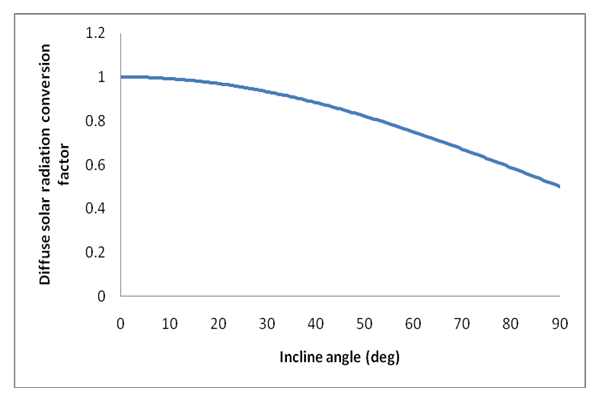
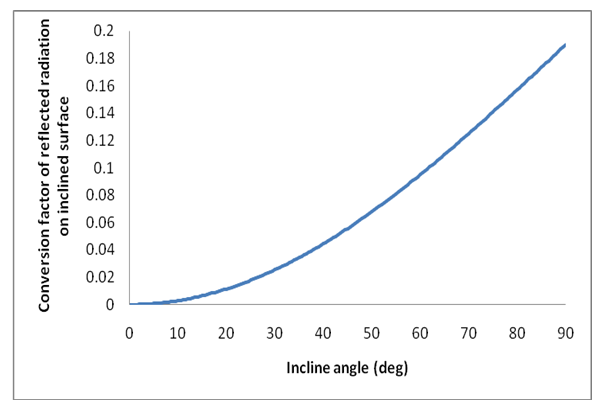
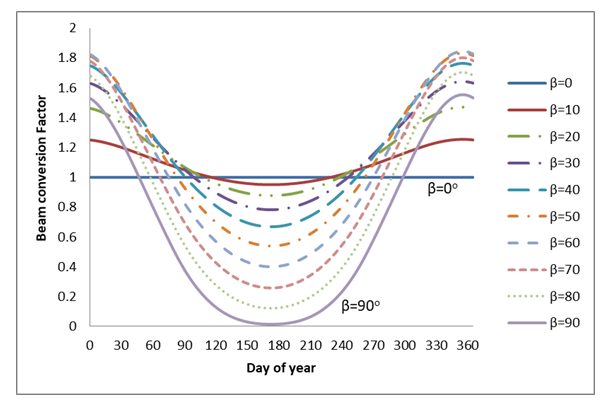
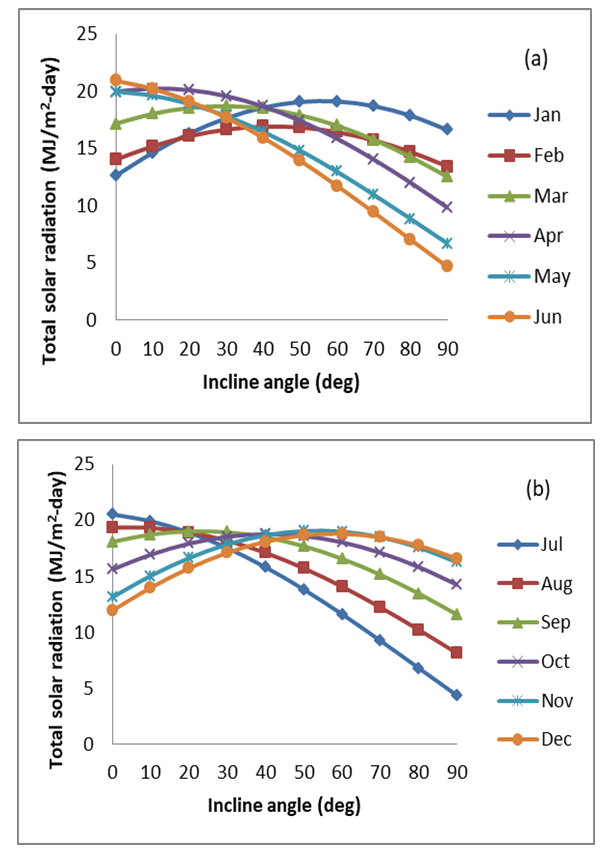
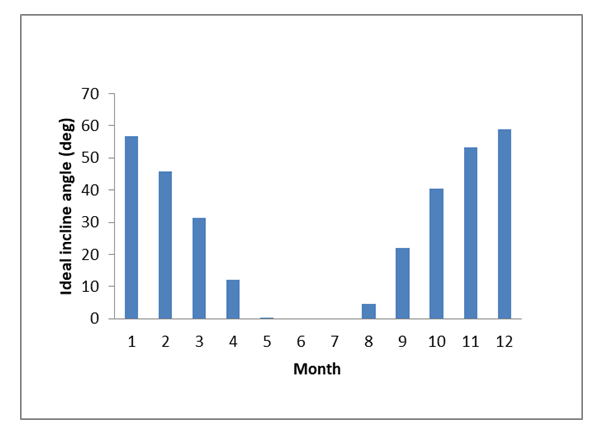
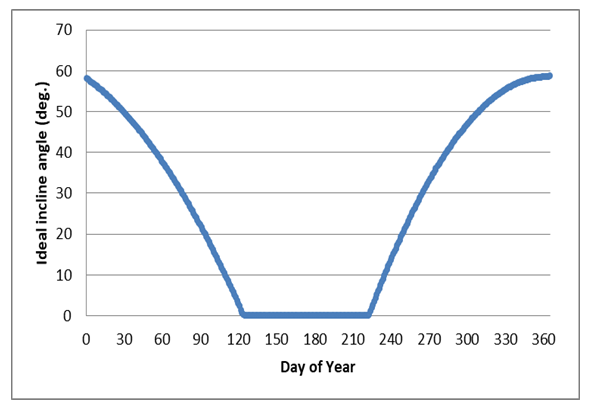

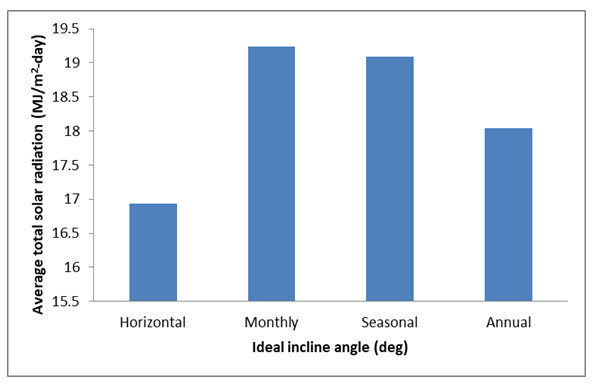

 Abstract
Abstract Reference
Reference Full-Text PDF
Full-Text PDF Full-text HTML
Full-text HTML